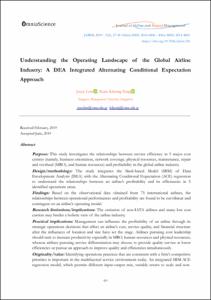Mostra el registre d'ítem simple
Understanding the Operating Landscape of the Global Airline Industry: A DEA Integrated Alternating Conditional Expectation Approach
| dc.contributor.author | Low, Joyce |
| dc.contributor.author | Yang, Kum Khiong |
| dc.date.accessioned | 2020-01-28T14:05:23Z |
| dc.date.available | 2020-01-28T14:05:23Z |
| dc.date.issued | 2019-12 |
| dc.identifier.citation | Low, J.; Yang, K. K. Understanding the Operating Landscape of the Global Airline Industry: A DEA Integrated Alternating Conditional Expectation Approach. "Journal of Airline and Airport Management", Desembre 2019, vol. 9, núm. 2, p. 27-45. |
| dc.identifier.issn | 2014-4806 |
| dc.identifier.uri | http://hdl.handle.net/2117/175951 |
| dc.description.abstract | Purpose: This study investigates the relationships between service efficiency in 5 major cost centres (namely, business orientation, network coverage, physical resources, maintenance, repair and overhaul (MRO), and human resources) and profitability in the global airline industry. Design/methodology/approach: The study integrates the Slack-based Model (SBM) of Data Envelopment Analysis (DEA) with the Alternating Conditional Expectation (ACE) regression to understand the relationships between an airline’s profitability and its efficiencies in 5 identified operations areas. Findings: Based on the observational data obtained from 75 international airlines, the relationships between operational performances and profitability are found to be curvilinear and contingent on an airline’s operating model. Research limitations/implications: The omission of non-IATA airlines and many low cost carriers may hinder a holistic view of the airline industry. Practical implications: Management can influence the profitability of an airline through its strategic operations decisions that affect an airline’s cost, service quality, and financial structure after the influences of location and size have set the stage. Airlines pursuing cost leadership should seek to increase productivity especially in MRO, human resources and physical resources; whereas airlines pursuing service differentiation may choose to provide quality service at lower efficiencies or pursue an approach to improve quality and efficiencies simultaneously. Originality/value: Identifying operations practices that are consistent with a firm’s competitive priorities is important in the multifaceted service environment today. An integrated SBM-ACE regression model, which permits different input-output mix, variable return to scale and non-linear relationship, is proposed and applied to analyze the profit impact of service efficiencies in the five key operations areas |
| dc.format.extent | 19 p. |
| dc.language.iso | eng |
| dc.publisher | OmniaScience |
| dc.rights | Attribution-NonCommercial 3.0 Spain |
| dc.rights.uri | http://creativecommons.org/licenses/by-nc/3.0/es/ |
| dc.subject | Àrees temàtiques de la UPC::Economia i organització d'empreses |
| dc.subject | Àrees temàtiques de la UPC::Enginyeria civil::Infraestructures i modelització dels transports::Infraestructures i transport aeri |
| dc.subject.lcsh | Aeronautics, Commercial--Economic aspects |
| dc.subject.other | Service quality |
| dc.subject.other | Efficiency |
| dc.subject.other | Cost-centric airlines |
| dc.subject.other | Service-centred airlines |
| dc.title | Understanding the Operating Landscape of the Global Airline Industry: A DEA Integrated Alternating Conditional Expectation Approach |
| dc.type | Article |
| dc.subject.lemac | Aviació comercial -- Aspectes econòmics |
| dc.identifier.doi | 10.3926/jairm.126 |
| dc.description.peerreviewed | Peer Reviewed |
| dc.rights.access | Open Access |
| local.citation.publicationName | Journal of Airline and Airport Management |
| local.citation.volume | 9 |
| local.citation.number | 2 |
| local.citation.startingPage | 27 |
| local.citation.endingPage | 45 |
Fitxers d'aquest items
Aquest ítem apareix a les col·leccions següents
-
2019, vol. 9, núm. 2 [5]
Recent Trends on Airline and Airport Management Research. 22nd ATRS World Conference


